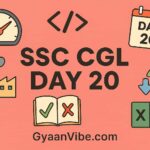GyaanVibe is a focused educational platform dedicated to helping SSC CGL aspirants crack Tier 1 & Tier 2 exam with a strategic, day-wise, and well-structured preparation approach.
SSC CGL Preparation – Day 2
✅ CPU: MCQs with Answers
Beginner Level
- What is the full form of CPU?
A. Central Programming Unit
B. Central Processing Unit
C. Control Processing Unit
D. Central Performance Unit
✅ Answer: B - Which part of the CPU performs arithmetic and logic operations?
A. Control Unit
B. ALU
C. Register
D. RAM
✅ Answer: B - The CPU is also known as the:
A. Heart of the computer
B. Operating System
C. Brain of the computer
D. Memory Unit
✅ Answer: C - Which component stores the address of the next instruction to be executed?
A. MAR
B. ALU
C. Program Counter
D. MDR
✅ Answer: C - What does the Control Unit do?
A. Perform calculations
B. Store data
C. Control the operations of all computer parts
D. Display output
✅ Answer: C
Intermediate Level
- Which register temporarily stores data fetched from memory?
A. IR
B. MDR
C. MAR
D. PC
✅ Answer: B - The CPU executes instructions using which cycle?
A. Read-Write Cycle
B. Instruction Memory Cycle
C. Fetch-Decode-Execute Cycle
D. ALU-CU-Memory Cycle
✅ Answer: C - What is the function of the Instruction Register (IR)?
A. To store current instruction being executed
B. To store data to be printed
C. To store images temporarily
D. To store memory addresses
✅ Answer: A - Which of the following is not a part of the CPU?
A. ALU
B. Control Unit
C. Monitor
D. Registers
✅ Answer: C - Which register holds the memory address of the data to be accessed?
A. MDR
B. MAR
C. Accumulator
D. IR
✅ Answer: B
Advanced/Conceptual Level
- Which of the following is true about multi-core processors?
A. They increase monitor refresh rate
B. They have multiple ALUs but one CU
C. They combine multiple processors in one chip
D. They reduce power consumption only
✅ Answer: C - What determines how many instructions a CPU can process per second?
A. Cache size
B. RAM type
C. Clock speed
D. Data bus width
✅ Answer: C - Which unit is used to measure CPU speed?
A. RPM
B. DPI
C. Hz
D. FPS
✅ Answer: C - The part of the CPU that directs the operation of the processor is called:
A. Memory
B. Control Unit
C. Register
D. Microprocessor
✅ Answer: B - In a CPU, where are intermediate results stored temporarily?
A. Hard disk
B. Cache memory
C. Registers
D. ROM
✅ Answer: C




